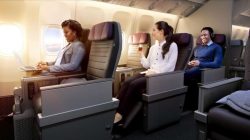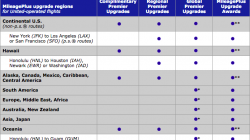There are a lot of moving parts going on these days as bankrupt American Airlines restructures under Chapter 11, with news outlets reporting nail-biting headlines surrounding merger rumors and endless negotiation strife between AMR management and its unions.
But not all news is necessarily bad news: this morning, American unveiled plans for the new interiors of its narrow body fleet deliveries, which are expected to arrive in 2014, and involve a lot of exciting hardware enhancements that will greatly improve the customer experience for its guests.
At present, American utilizes several fleet types on its domestic short-haul and transcontinental flights, including the McDonnell Douglas MD-80, the Boeing 737, 757 and 767 series. While safe and reliable aircraft, American intends to phase-out all of them (with the exception of the 737) as part of its fleet-renewal program that calls for improved fuel efficiency and an industry-leading premium travel experience.
As part of the program, American has confirmed over 200 narrow-body orders from aircraft manufacturers Boeing and Airbus that will be joining its fleet throughout the rest of the decade. Airbus will be delivering 130 of its Airbus A321 and A319 variants to the carrier, and Boeing will deliver 100 737-800s which feature the Next Generation Boeing Sky Interior (BSI).
Elevating the experience across the board
Perhaps the most ground-breaking component of the product enhancements entails in-flight entertainment, as each new narrow body plane will have a personal in-seat entertainment screen across all cabin classes on the new planes, as well as individual 110 volt universal AC power outlets and USB jacks. In addition to offering passengers a standard selection of movies, television programs, games, and audio selections to choose from, the screens will also feature seat-to-seat chat, live text news and weather updates, 3-D moving maps, airport terminal maps, and connecting gate information.
The screens will measure 8.9 inches in the Main Cabin, and either 12.1 inches or 15.4 inches in the Premium Cabins, depending on route (addressed further in this posting). The new all-leather seats in the Main Cabin will be designed by Recaro in a 3 by 3 seating configuration.
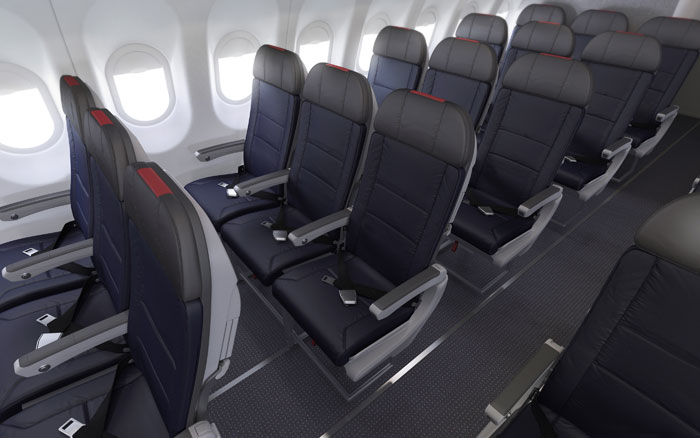
Each new aircraft will also feature Main Cabin Extra, one of American’s newest cabin-renewal initiatives announced earlier this year, which will offer customers more 4-6″ of extra leg room and priority boarding.
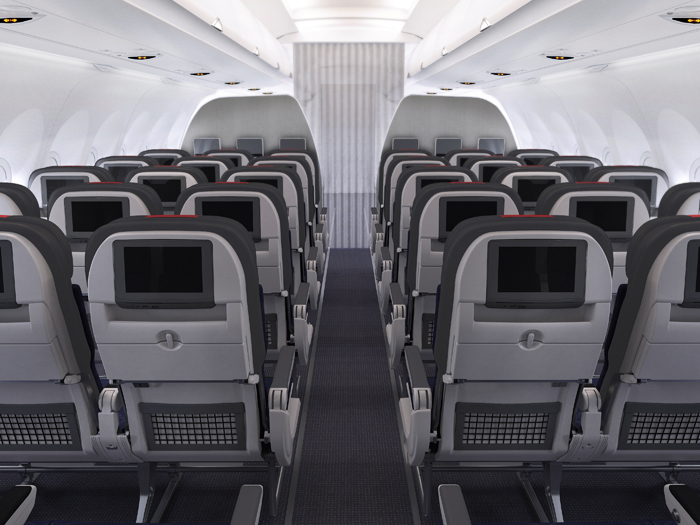
Segmentation: a separate offering on transcontinental services
Core to American’s business model is attracting the premium class sector, as the carrier has always prized its higher revenue-paying corporate travelers on its coast-to-coast routes. At present, American offers a three-class cabin configuration on such flights (First, Business, Coach) primarily on older 767-200 aircraft in a move designed to attract top-dollar paying travelers on these highly-competitive markets. The majority of American’s domestic short-to-medium haul services currently only feature a dual class offering (Domestic First and Regular Economy).
However, it is no secret that American has done little in terms of making innovative investments to upgrade their transcontinental product, and that has not come without costs. The economics of the Boeing 767 have lost their competitive advantage, especially as oil prices have risen and the aircraft has become expensive to maintain and repair through depreciation. The cabin interiors largely reflect styles of the 1980’s and 1990’s, lacking modernized amenities that have become quite commonplace across the global airline industry.
The competitive landscape is also challenging. As is, rival carriers Delta Air Lines and United vie against American for market share on these transcontinental routes, particularly on the lucrative New York to Los Angeles and New York to San Francisco corridors. United, in particular, offers a uniquely branded p.s. Premium Service offering specifically on these two routes, which indeed is a major competitive threat to American. Not to mention the fact that new low-cost carrier entrants such as Richard Branson startup Virgin America and JetBlue Airways have successfully entrenched themselves in the same arena, eating into American’s market share and profits.
Therefore, American will be stepping up its game by continuing along the same path of offering a three-cabin class on its transcontinental flights, which will see the A321 replace the current gas-guzzling Boeing 767. American’s domestic First Class cabin will be outfitted with 10 fully lie-flat seats in a 1-1 seating configuration, providing every passenger with direct window and aisle access.
This will be, by far, a feature no other US carrier currently offers on domestic services.
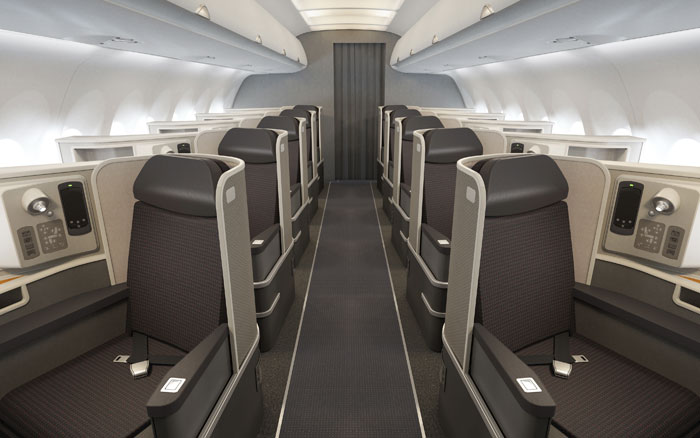
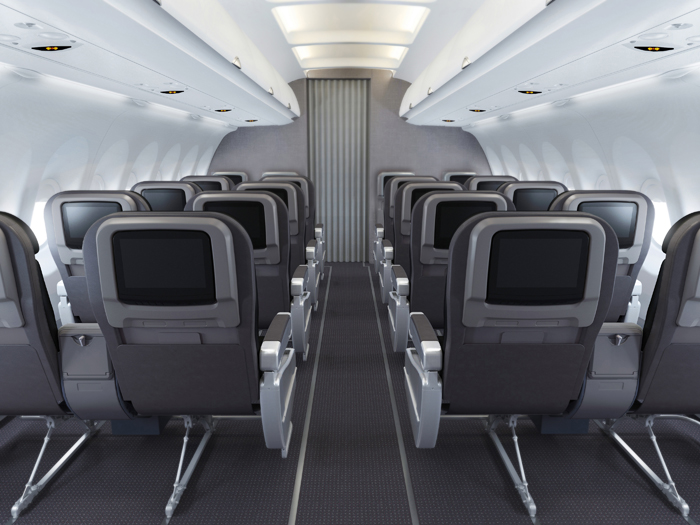
American’s Business Class cabin on the transcontinental routes will also contain 20 fully lie-flat seats in a 2-2 seating configuration, which, along with First, will offer a 15.4 inch HD capable touchscreen monitor along with the provision of Bose QuietComfort 15 Acoustic Noise Cancelling headsets to each passenger.
Signs of strategic shift
In the Main Cabin, the transcontinental A321s will feature the same upgraded product investments to be installed across the entire narrowbody AA fleet. However, particularly interesting is that there will only be 72 seats total: 36 for Main Cabin Extra, and 36 for regular Main Cabin. Combined with First and Business, the transcontinental A321s will only offer a total of 102 seats altogether on each flight, a significant decline from the current seating capacity of 168 seats on the same routes.
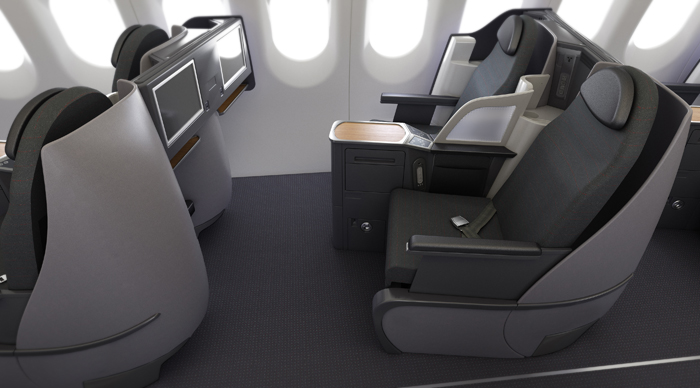
This interesting move certainly underscores a strategic shift away from filling a high-density plane across multiple fare classes, as clearly here American has retained the focus on providing X number of Premium seats while silently scaling back on the number of non-premium seats. Not surprisingly, the inroads that incumbent carriers such as Virgin and JetBlue have certainly hurt American’s yields on these routes, as the newer players have successfully managed to attract lower-paying passengers with attractive fares and enhanced in-flight services. Both JetBlue and Virgin have offered amenities such as in-seat personal entertainment screens and extra legroom options for many years, while American’s standard coach offering has remained relatively stagnant.
Therefore, American has realized its best interests are to continue chasing after the higher-yielding premium sector with an unprecedented cabin offering (in the form of a lie-flat seats). If American is successful in this venture, then the profit margins will certainly bear fruit on its bottom line. However, one reality from this dramatic change is that frequent fliers who are accustomed to booking tickets in the Economy Class cabin and getting upgraded to Business class often will find this option increasingly more challenging from here on out.
Part of a long list of changes
American has gradually announced new product developments over the months, trickling down from their long-haul international services to now finally touching upon their plans for their domestic in-flight offering. In February, American began serving complimentary beer and wine in all travel classes on international flights to Europe, Asia and deep South America.
This is probably one of the most high-profile announcements American has made in well over a decade, as the carrier has indeed fallen behind the times in offering a competitive core product offering to retain a large loyalty following from the flying public.
To access a neat video which details all of the new product enhancements, click here. (full-screen viewing available).
Benefits at a Glance
In case the above information was confounding, below is a chart, taken directly from American Airlines press release, detailing the individual enhancements on its new aircraft deliveries, including the new widebody 777-300ER, which are expected to arrive in December.
For more information, visit www.aa.com/flybetter or www.aa.com/newplanes. Congratulations to American Airlines and OneWorld for taking some exciting steps towards improving the guest experience.
| Features | New North American Fleet A321, A319 and 737-800 |
NewCoast-to-CoastFleet A321 Transcon |
New International Fleet 777-300ER |
|---|---|---|---|
| Personal, in-seat entertainment | x | x | x |
| Wi-Fi | x | x | x |
| Individual 110v universal AC power outlets | x | x | x |
| USB jacks | x | x | x |
| 3-class configuration | x1 | x | |
| Fully lie-flat First and Business Class Seats | x1 | x | |
| Aisle access from every First Class seat | x | x | |
| Aisle access from every Business Class seat | x | ||
| Main Cabin Extra | x | x | x |
| Leather Seats throughout every cabin | x | x | x |
| Premium cabin walk-up bar with snacks and drinks | x | ||
| 1Will be available only on American | |||


